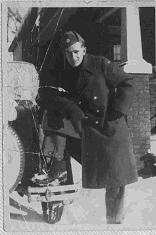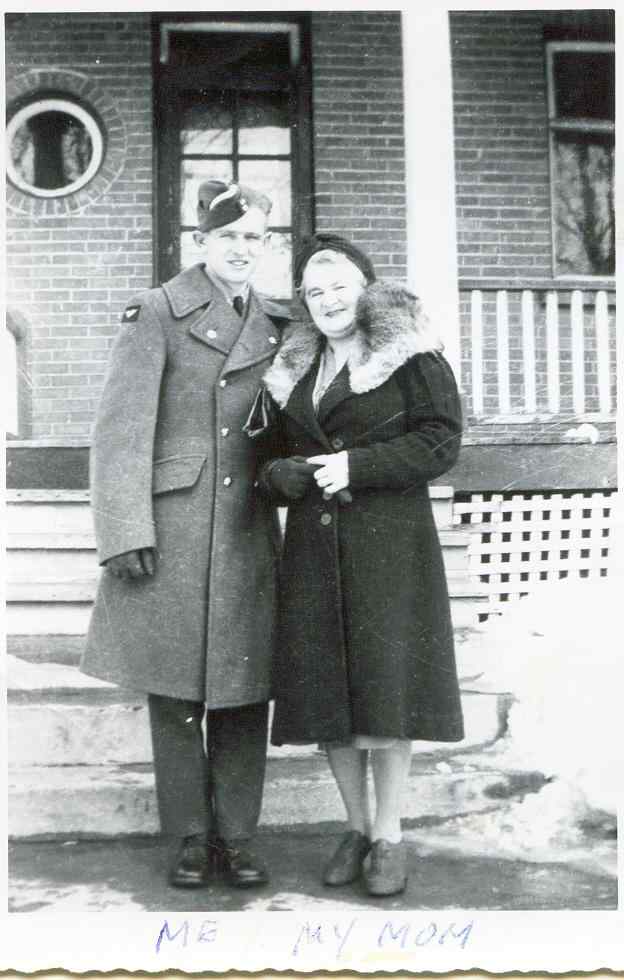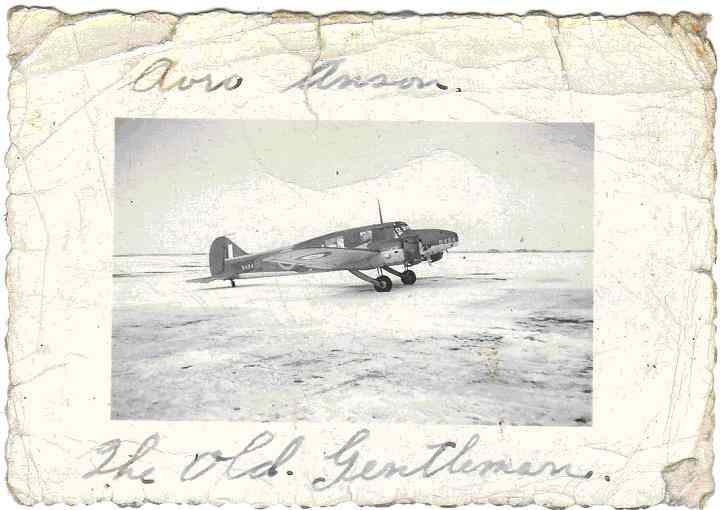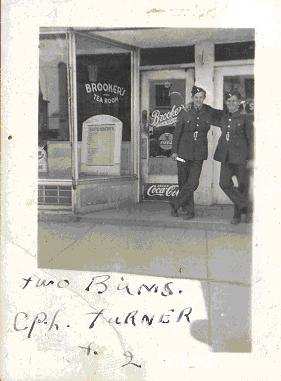The journey from recruit to pilot or other aircrew trades changed greatly from the initial training sequence of 1940 to the more intense training sequence started in September of 1942. Then again the training was improved and lengthened in the new
plan of February 1944. The British Commonwealth Air Training Plan was to train fifty thousand aircrew each year for the war effort. Canada, as President Roosevelt stated had become the
"Airdrome of Democracy". This part of his speech, unknown to the President, had been written for him by Lester Pearson who later become Prime Minister. Canada was by far the largest of the group other then the UK to take part by suppling more funds and men to the plan
then Australia and New Zealand who also trained their air forces in Canada.
By following the path and photos of one future "Mooseman" Robert Barnes we can get a look at the steps these men would take to become the future crewmen of not only
the 419 squadron but other RCAF, RAAF, RNZAF and Norwegian air force squadrons.
RECRUITING
Robert Barnes was eighteen years old when he decided to enlist in the Royal Canadian Air Force. But 1938 was a time when the RCAF was a small force of around 4000. The RCAF did provide training for flight crews but did not have the aircraft for them to fly. Of a class of over 20 sucessfull airmen found out when only one of them was
accepted as a pilot!
After waiting for a long period of time for his acceptance by the RCAF, Robert Wellington Barnes enlisted in the Candian Army.


This did not seem to be an usual situation, looking at my father's notes
he experienced the same delay in the process, in my fathers case he enlisted just after Canada declared war and the confusion he experienced mirrored that of Robert Barnes. The additional huge influx of volunteers from the United States
with men who wanted to learn to fly and fight made the process an embarrassment to the government. There were more recruits then they could handle. So future Mooseman Barnes came into the RCAF in 1941 at a point where everything was in
short supply. There was not enough NCOs to put in charge of the new recruits. Men with previous military experince of any kind were placed in charge to help keep things moving. Eventually my own father and many others would be recalled back to the Recruitment Centers for their medicals and some testing, signing the enlistment papers and
taking an oath to the King to serve until the war was over.
 Manning Depot
Manning Depot
After the trials and waiting of the Recruitment procedure the enlisted men were assigned to a Manning Depot and there were many across Canada. Barnes makes no reference to having been in
a Manning Depot. It may have been because of his Army training that he sidestepped this rung on the training ladder. The basic way to look at the activities of the Manning Depots were to turn civilians into soldiers, or at least
in the case of the RCAF get them into military ways of doing things. Looking at my fathers notes the routine was learning to march, getting needles, marching, getting needles, learning to salute, getting needles, rifle drill, learning to polish boots
and brass properly, learning your right foot from your left also more needles. As an Airman Second Class my father would receive $1.30 per day, when my dad became an LAC it increased to $2.00 per day. Uniforms were in short supply and he mentioned he never received his "blues" until the day before he left the Manning Depot which happened to be
in the CNE grounds in Toronto. For men such as Barnes with his Army training and my father who grew up in an Army family the routine would not have been intimidating. While for others it was whole new experience following orders and obeying them without question.
 Initial Training School
Initial Training School
It would be here at the ITS that the future of the new recruits vocation in the aircrew would be determined. The Link Trainer was like a small airplane almost like a child’s coin ride in the supermarket.
The invention of Edwin Link and almost rejected by the military the device proved itself when the war broke out. It provided a safe on the ground evaluation of the candidates for pilot .

The Link had controls similar to a real aircraft and would respond as real aircraft would . An instructor at a console located near the trainer could simulate conditions that an aircraft would encounter in the air.
To fully test the candidates these situations encountered became more and more complex. Testing reaction times and how the Link pilot overcame the situations thrown at them helped determine who passed and would find themselves moving on to be fighter or multi-engine pilots. On the other hand those who may have not quite matched the expectations of the
instructors would be off to navigation, gunnery, wireless or bomb aimer courses. Although almost everyone had thoughts of being a pilot, there were those who wanted from the very begining to be in one of the other positions on the crew. ITS was the start of sorting out the abilities of each person, although maybe not always correct, it was a beginning.
At the Initial Training School in Edmonton, one of many across Canada, Barnes tried his hand at flying. In the early days, 1941 when Robert Barnes was at ITS, the training was only four weeks in later years it would expand out to
10 weeks. The next step for Barnes was to the Elementary Training School.
Elementary Flying Training School
This is would were it would begin for those who yearned to be a pilot. The chance to actually fly. And for some being "washed out", injured or worse. Of the 58,644 pilot trainees to enter EFTS 13,200 failed ; this number does not count those who became ill, injured or were killed.
Fatal accidents were a fact of life while learning to fly. In the early days of BCAPT one fatal crash occurred for every 11,000 hours of flying time, this would improve to one in every 24,000 hours in the next few years as BCAPT learned and grew. Not all accidents were technicaly accidental. Daredevil activities by new pilots without the skills to perform them
took a toll. In many cases the court martials that did take place for these activities certainly must have saved lives. During 1941 170 fatal incidents occurred, 40 by low flying aerobatics, 37 aircraft stalling, 31 during night training, 20 air collisions, 15 from faulty equipment or instruments and 27 to other causes.
Airman Barnes was stationed at #35 EFTS in Neepawa Manitoba at this time. And his intoduction to flying was on the Tiger Moth.

A biplane aircraft which provided the RCAF with a good starter aircraft, 20 flying schools were supplied with Tiger Moths which in their career topped one and three quarter million hours of flying time.
By 1943 the RCAF needed a more advanced trainer to match the needs of the newer front line aircraft in service overseas. And so the Fairchild Cornell became the next choice to replace the Moth. Over sixteen hundred Canadian built Cornells were manufactured in Fort Erie Ontario by Fleet Aircraft.
The Cornells had structural problems with wings which required more inspections of airframes in addition to strengthening the wing spar. And so were not as well thought of as other trainers.


The dangers of training and the pressure of studies in addition to being far from home would have an effect on all those who were serious about flying. With one in five trainees failing, the pressure to suceed and move on to the next level of training was high in many of the students causeing not only accidents but
emotional stress.
Having friends to divert your attention was a necessary part of the live.
And if you were lucky enough you could get leave to go home between the schools to be with family. Well nothing could beat home cooking and the every day events of
life that now seemed so easy.
 Service Flying Training School
Service Flying Training School
In 1942 Robert Barnes was posted to Service Flying Training School #36 at Penold Alberta. Classes of 30 and up to 60 trainees who were destined to fly multi-engine aircraft
began to be taught the skills needed to prepare for even larger aircraft. For it wasn't only bomber command that these pilot trainees may end up. Other Commands were in need of pilots with multi-engine rateings. Robert Barnes and many others were trained on Airspeed Oxfords and Ansons.

The training again brought together men from all different walks of life, regions of Canada and other countries. If you were lucky your pals from EFTS would also be assigned to the same SFTS. Life at SFTS was far different from EFTS where instruction in aircraft and flying were more prevalent then
parades and marching. Service Flying bases were all business, military business. Spit and polish, regulations and it seemed always under the eye of the Flight Sergeant looking for any fault in uniforms or behavior. A way of getting everyone ready for squadron live.

The studying and the training would continue for 10 more weeks. Accidents and washouts still occurred as the classes progressed. In Barnes case he was lucky enough to be trained directly on an Anson, a multi-engined trainer which during this time was
scarce. Some pilots who were to fly multi-engined aircraft learned skills on the plentiful Harvard, an aircraft which had a wicked tendency to swing out of control on landing. (See second photo down at left). These pilots would then have to be retrained on multi engines later on.
In addition to accidents the daredevil stunts of some students did not stop. The two Cessna Cranes in the third photo down on the left collided on the ground; no one was hurt which was a miracle. More then one pilot trainee was a member of a funeral parade for
a member of the group who was killed. In the bottom photo on the left two trainees died and became the first casualties at #12 SFTS Brandon Manitoba.

Stunts were always the talk of the bases, when I my father was at #1 Technical Training School at St. Thomas the most copied stunt was to fly under one of the bridges around the Niagara Falls.
Or if you were really crazy enough as one fellow was reported to have done, flying over the border and landing at Detroit airport having lunch then leaving in his bright yellow Harvard.
Life After SFTS
From 1940 to September 1942 the successful pilot with his new Sergeants stripes and wings would be assigned to the Overseas Pool to be posted to squadron duties or they may be asked to be instructors for BCAPT. After September 1942 other
options were available in the form of General Reconnaissance School training, assignment to an Operational Training Unit, assigned to home defense or the Overseas Pool.
Operational Training Units
Operational Training Units in Bomber Command were used to build crews into working teams Groups of men were either put together by an officer or
they themselves put together their own crews. The mixing and matching of individuals who had to work as a tight unit counting on each other did not always happen at first try. And some would stand out as unplaceable. Sgt. Barnes describes the operations of the unit as "milk runs". Usually flying the older two engine bombers such as Wellingtons flying over enemy territory.
With the idea was to become familar with the elements of war that they would be thrown into fully in the next few months. The assignments were not always without losses, in lists of lost aircraft; the number of aircraft in OTUs is quite large.
Heavy Conversion Units
OTU was not the end of the training in many cases, before being assigned to a squadron. As many RCAF bomber squadrons were equiped four engined Heavy Bombers such as Halifax and Lancaster the pilots and crews were sent to Heavy Conversion Units were additional crew members were added and tried to blend in with an
existing team. The whole crew would have to be trained on the equipment and instruments of their trades on their new aircraft. After his time in HCU W/O Barnes then became a Mooseman with 419 squadron. More on W/O Barnes is found in the Moosemen section.





 This did not seem to be an usual situation, looking at my father's notes
he experienced the same delay in the process, in my fathers case he enlisted just after Canada declared war and the confusion he experienced mirrored that of Robert Barnes. The additional huge influx of volunteers from the United States
with men who wanted to learn to fly and fight made the process an embarrassment to the government. There were more recruits then they could handle. So future Mooseman Barnes came into the RCAF in 1941 at a point where everything was in
short supply. There was not enough NCOs to put in charge of the new recruits. Men with previous military experince of any kind were placed in charge to help keep things moving. Eventually my own father and many others would be recalled back to the Recruitment Centers for their medicals and some testing, signing the enlistment papers and
taking an oath to the King to serve until the war was over.
This did not seem to be an usual situation, looking at my father's notes
he experienced the same delay in the process, in my fathers case he enlisted just after Canada declared war and the confusion he experienced mirrored that of Robert Barnes. The additional huge influx of volunteers from the United States
with men who wanted to learn to fly and fight made the process an embarrassment to the government. There were more recruits then they could handle. So future Mooseman Barnes came into the RCAF in 1941 at a point where everything was in
short supply. There was not enough NCOs to put in charge of the new recruits. Men with previous military experince of any kind were placed in charge to help keep things moving. Eventually my own father and many others would be recalled back to the Recruitment Centers for their medicals and some testing, signing the enlistment papers and
taking an oath to the King to serve until the war was over.

 The Link had controls similar to a real aircraft and would respond as real aircraft would . An instructor at a console located near the trainer could simulate conditions that an aircraft would encounter in the air.
To fully test the candidates these situations encountered became more and more complex. Testing reaction times and how the Link pilot overcame the situations thrown at them helped determine who passed and would find themselves moving on to be fighter or multi-engine pilots. On the other hand those who may have not quite matched the expectations of the
instructors would be off to navigation, gunnery, wireless or bomb aimer courses. Although almost everyone had thoughts of being a pilot, there were those who wanted from the very begining to be in one of the other positions on the crew. ITS was the start of sorting out the abilities of each person, although maybe not always correct, it was a beginning.
At the Initial Training School in Edmonton, one of many across Canada, Barnes tried his hand at flying. In the early days, 1941 when Robert Barnes was at ITS, the training was only four weeks in later years it would expand out to
10 weeks. The next step for Barnes was to the Elementary Training School.
The Link had controls similar to a real aircraft and would respond as real aircraft would . An instructor at a console located near the trainer could simulate conditions that an aircraft would encounter in the air.
To fully test the candidates these situations encountered became more and more complex. Testing reaction times and how the Link pilot overcame the situations thrown at them helped determine who passed and would find themselves moving on to be fighter or multi-engine pilots. On the other hand those who may have not quite matched the expectations of the
instructors would be off to navigation, gunnery, wireless or bomb aimer courses. Although almost everyone had thoughts of being a pilot, there were those who wanted from the very begining to be in one of the other positions on the crew. ITS was the start of sorting out the abilities of each person, although maybe not always correct, it was a beginning.
At the Initial Training School in Edmonton, one of many across Canada, Barnes tried his hand at flying. In the early days, 1941 when Robert Barnes was at ITS, the training was only four weeks in later years it would expand out to
10 weeks. The next step for Barnes was to the Elementary Training School.
 A biplane aircraft which provided the RCAF with a good starter aircraft, 20 flying schools were supplied with Tiger Moths which in their career topped one and three quarter million hours of flying time.
By 1943 the RCAF needed a more advanced trainer to match the needs of the newer front line aircraft in service overseas. And so the Fairchild Cornell became the next choice to replace the Moth. Over sixteen hundred Canadian built Cornells were manufactured in Fort Erie Ontario by Fleet Aircraft.
The Cornells had structural problems with wings which required more inspections of airframes in addition to strengthening the wing spar. And so were not as well thought of as other trainers.
A biplane aircraft which provided the RCAF with a good starter aircraft, 20 flying schools were supplied with Tiger Moths which in their career topped one and three quarter million hours of flying time.
By 1943 the RCAF needed a more advanced trainer to match the needs of the newer front line aircraft in service overseas. And so the Fairchild Cornell became the next choice to replace the Moth. Over sixteen hundred Canadian built Cornells were manufactured in Fort Erie Ontario by Fleet Aircraft.
The Cornells had structural problems with wings which required more inspections of airframes in addition to strengthening the wing spar. And so were not as well thought of as other trainers.

 The dangers of training and the pressure of studies in addition to being far from home would have an effect on all those who were serious about flying. With one in five trainees failing, the pressure to suceed and move on to the next level of training was high in many of the students causeing not only accidents but
emotional stress.
Having friends to divert your attention was a necessary part of the live.
And if you were lucky enough you could get leave to go home between the schools to be with family. Well nothing could beat home cooking and the every day events of
life that now seemed so easy.
The dangers of training and the pressure of studies in addition to being far from home would have an effect on all those who were serious about flying. With one in five trainees failing, the pressure to suceed and move on to the next level of training was high in many of the students causeing not only accidents but
emotional stress.
Having friends to divert your attention was a necessary part of the live.
And if you were lucky enough you could get leave to go home between the schools to be with family. Well nothing could beat home cooking and the every day events of
life that now seemed so easy.

 The training again brought together men from all different walks of life, regions of Canada and other countries. If you were lucky your pals from EFTS would also be assigned to the same SFTS. Life at SFTS was far different from EFTS where instruction in aircraft and flying were more prevalent then
parades and marching. Service Flying bases were all business, military business. Spit and polish, regulations and it seemed always under the eye of the Flight Sergeant looking for any fault in uniforms or behavior. A way of getting everyone ready for squadron live.
The training again brought together men from all different walks of life, regions of Canada and other countries. If you were lucky your pals from EFTS would also be assigned to the same SFTS. Life at SFTS was far different from EFTS where instruction in aircraft and flying were more prevalent then
parades and marching. Service Flying bases were all business, military business. Spit and polish, regulations and it seemed always under the eye of the Flight Sergeant looking for any fault in uniforms or behavior. A way of getting everyone ready for squadron live. The studying and the training would continue for 10 more weeks. Accidents and washouts still occurred as the classes progressed. In Barnes case he was lucky enough to be trained directly on an Anson, a multi-engined trainer which during this time was
scarce. Some pilots who were to fly multi-engined aircraft learned skills on the plentiful Harvard, an aircraft which had a wicked tendency to swing out of control on landing. (See second photo down at left). These pilots would then have to be retrained on multi engines later on.
In addition to accidents the daredevil stunts of some students did not stop. The two Cessna Cranes in the third photo down on the left collided on the ground; no one was hurt which was a miracle. More then one pilot trainee was a member of a funeral parade for
a member of the group who was killed. In the bottom photo on the left two trainees died and became the first casualties at #12 SFTS Brandon Manitoba.
The studying and the training would continue for 10 more weeks. Accidents and washouts still occurred as the classes progressed. In Barnes case he was lucky enough to be trained directly on an Anson, a multi-engined trainer which during this time was
scarce. Some pilots who were to fly multi-engined aircraft learned skills on the plentiful Harvard, an aircraft which had a wicked tendency to swing out of control on landing. (See second photo down at left). These pilots would then have to be retrained on multi engines later on.
In addition to accidents the daredevil stunts of some students did not stop. The two Cessna Cranes in the third photo down on the left collided on the ground; no one was hurt which was a miracle. More then one pilot trainee was a member of a funeral parade for
a member of the group who was killed. In the bottom photo on the left two trainees died and became the first casualties at #12 SFTS Brandon Manitoba. Stunts were always the talk of the bases, when I my father was at #1 Technical Training School at St. Thomas the most copied stunt was to fly under one of the bridges around the Niagara Falls.
Or if you were really crazy enough as one fellow was reported to have done, flying over the border and landing at Detroit airport having lunch then leaving in his bright yellow Harvard.
Stunts were always the talk of the bases, when I my father was at #1 Technical Training School at St. Thomas the most copied stunt was to fly under one of the bridges around the Niagara Falls.
Or if you were really crazy enough as one fellow was reported to have done, flying over the border and landing at Detroit airport having lunch then leaving in his bright yellow Harvard.